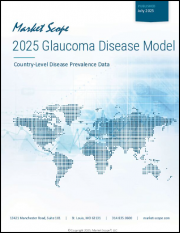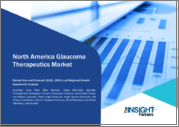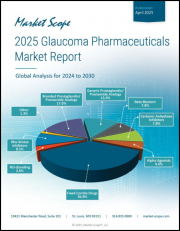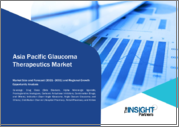
|
시장보고서
상품코드
1829439
녹내장 치료 시장 : 치료법 유형별, 약제 클래스별, 투여 경로별, 제품 유형별, 유통 채널별, 최종 용도별 - 세계 예측(2025-2032년)Glaucoma Treatment Market by Treatment Type, Drug Class, Route Of Administration, Product Type, Distribution Channel, End Use - Global Forecast 2025-2032 |
||||||
녹내장 치료 시장은 2032년까지 CAGR 9.26%로 148억 5,000만 달러로 성장할 것으로 예측됩니다.
| 주요 시장 통계 | |
|---|---|
| 기준연도 2024 | 73억 1,000만 달러 |
| 추정연도 2025 | 79억 9,000만 달러 |
| 예측연도 2032 | 148억 5,000만 달러 |
| CAGR(%) | 9.26% |
현재 녹내장 치료 환경에 대한 종합적인 오리엔테이션 임상적 우선순위, 기술 혁신의 궤적, 이해관계자 협력에 대한 과제에 대해 집중 조명
녹내장은 진행성 시신경 손상과 시력과 삶의 질을 위협하는 만성 안압 관련 장애를 특징으로 하는 만성적인 임상적 문제입니다. 치료법은 안압 강하뿐만 아니라 신경 보호, 지속적 약물전달, 수술 전후 위험 감소를 위한 저침습적 접근법 등 보다 광범위한 임상 목표로 확대되고 있습니다. 레이저 프로토콜, 기기 혁신, 약리학적 메커니즘의 발전은 치료 순응도 개선, 치료 부담 감소, 장기적인 시력 결과 최적화라는 의료 시스템의 요구에 수렴하고 있습니다.
임상의, 지불자, 제조업체는 현재 기술 혁신의 주기, 규제에 대한 기대, 상환 압력 및 치료 제공의 변화와 상호 작용하는 복잡한 생태계에서 활동하고 있습니다. 그 결과, 벤치에서 침대 옆으로 이어지는 번역 경로에는 실제 엔드포인트와 환자 중심 지표와의 명확한 정합성이 필요합니다. 이 소개는 진화하는 녹내장 치료 분야에서 임상 도입, 조달 역학, 파트너십 기회를 탐색하려는 이해관계자들을 위한 실용적인 인텔리전스에 초점을 맞춘 집중적인 분석의 장을 마련합니다.
이어지는 섹션에서는 기술 변곡점, 정책 개발, 세분화 인사이트, 지역적 고려사항, 전략적 제안을 통합하여 증거에 기반한 의사결정을 내리고 효과적인 상업화 및 임상 통합을 촉진하는 것을 목표로 합니다.
저침습적 치료, 서방형 치료, 새로운 약리학적 메커니즘, 디지털 건강이 녹내장 치료의 임상 경로와 상업적 모델을 재구성하는 방식
지난 10년동안 임상의와 업계가 녹내장 관리에 접근하는 방식을 재정의하는 몇 가지 혁신적인 변화가 발생했습니다. 첫째, 최소침습 수술의 등장으로 조기 개입의 위험-편익 계산이 재검토되고, 외과의사는 합병증을 최소화하면서 시야를 확보하기 위해 기기를 이용한 옵션을 더 빨리 고려하게 되었습니다. 동시에, 서방형 약물전달 시스템은 외용제 요법의 빈도와 복잡성을 줄임으로써 순응도를 개선하고 치료 경로를 장기적인 유지 전략으로 재구성하고 있습니다.
약리학적인 측면에서 rho 키나아제 억제 및 표적 신경 보호제와 같은 새로운 메커니즘은 기존의 압력 강하제 범주를 넘어 치료 툴 상자를 확장하고 질병 진행의 여러 측면을 다루는 병용 접근법을 위한 기회를 창출하고 있습니다. 의료제도와 지불자는 점점 더 가치 기반 결과에 초점을 맞추고 있으며, 이에 따라 제조업체는 실제 효과와 의료 경제적 이익을 입증해야 하는 상황에 직면해 있습니다. 원격 모니터링에서 순응도 플랫폼에 이르기까지 디지털 헬스 통합은 환자와 의료진과의 접점을 더욱 변화시키고, 개인화된 치료 결정을 지원하는 보다 풍부한 종단적 데이터세트를 가능하게 하고 있습니다.
이러한 변화를 종합하면 새로운 상업적 모델, 공동 임상시험, 의료 전문가를 위한 맞춤형 교육 등을 적시에 적절하게 도입해야 합니다. 그 결과, 보다 세분화되어 있지만 기회가 풍부한 상황이 만들어지고, 차별화된 임상적 증거와 실용적인 도입 전략에 따라 어떤 혁신이 규모를 확장할 수 있는지가 결정될 것입니다.
2025년 미국 관세 조정이 안과 의료기기, 치료법, 공급망에 미치는 업무, 조달, 임상 지속성에 미치는 영향 평가
2025년 정책 변화와 무역 역학, 특히 미국에서 제안된 관세 조정은 안과 의료기기, 소모품 및 의약품 성분을 공급하는 기업에게 새로운 업무상의 복잡성을 야기하고 있습니다. 관세 변화는 제조 기지 결정, 조달 일정, 공급업체와의 계약에 영향을 미칠 수 있으며, 단기적인 전술적 조정과 장기적인 전략적 재조정을 촉진할 수 있습니다. 수직적으로 통합된 공급망과 다각화된 생산기지를 보유한 제조업체는 단일 공급원 수입에 의존하는 제조업체보다 당면한 비용 압박을 더 효과적으로 완화할 수 있는 위치에 있습니다.
임상의와 병원 시스템은 기기화된 치료 및 일회용 기기의 가격 책정 궤도 수정에 직면 할 수 있으며, 이는 구매 패턴과 입찰 결과에 영향을 미칠 수 있습니다. 대량 구매 및 전략적 재고를 유지하는 의료 시스템은 임상적 긴급성과 예상 이용률 및 비용의 영향을 비교 검토하게 됩니다. 한편, 규제기관과 전문학회는 치료의 연속성과 환자 접근성을 중시할 가능성이 높으며, 치료 중단을 방지하기 위한 임시 조달 가이드라인이나 일시적인 상환 조정을 촉구할 가능성이 높습니다.
업계의 관점에서 볼 때, 가장 건설적인 대응은 공급업체와의 긴밀한 협력, 돌발 상황에 대비한 조달, 리드타임 및 가격 영향에 대한 고객과의 투명한 커뮤니케이션을 포함합니다. 다양한 관세 결과를 고려한 시나리오 계획은 상업 및 공급망 팀이 지역 제조 및 전략적 비축을 위한 제품 라인의 우선순위를 결정하는 데 도움이 되며, 환자 치료 중단을 보장하기 위해 지역 규제 준수 및 품질 보증에 대한 투자를 지속할 수 있도록 돕습니다.
치료 방식, 약리학적 클래스, 투여 경로, 제품 유형, 유통 채널, 치료 환경을 임상 및 상업적 수요 동인과 연관시키는 다차원 세분화 분석
세분화된 세분화 접근 방식을 통해 치료 유형, 약효군, 투여 경로, 제품 유형, 유통 채널, 최종 용도별로 임상적 미충족 니즈와 상업적 기회가 교차하는 지점을 명확히 파악합니다. 치료 유형별로 분석하면, 아르곤 레이저 섬유주 성형술, 내세포 광응고요법, 선택적 레이저 섬유주 성형술과 같은 레이저 선택은 배수장치 이식, 최소침습 녹내장 수술의 변형, 섬유주 절제술과 같은 수술적 경로와 차별화된 채택 촉진요인을 보이고 있으며, 저침습 코호트는 Hydrus, iStent, Xen Gel Stent 기술로 더욱 차별화되고 있습니다. 이러한 구분은 임상적 포지셔닝, 교육 필요성, 설비 투자 결정에 중요한 역할을 합니다.
약제군별 세분화를 평가하면, α-작용제, 베타-차단제, 탄산탈수효소 억제제, 미오틱, 프로스타글란딘 유사체, Rho 키나아제 억제제에 대해 임상적 역할과 수명주기 고려사항이 다르다는 것을 알 수 있습니다. 각 클래스의 내약성 프로파일, 모니터링의 필요성, 서방형 플랫폼과의 적합성은 각각 다르며, 이는 처방 행동과 처방 배치에 영향을 미칩니다. 서방형, 전신형, 국소형과 같은 투여 경로의 구분은 의사의 선호도와 환자의 수용성 모두에 영향을 미치는 순응도의 의미와 필요한 시술 리소스를 명확히 합니다.
브랜드 의약품과 제네릭 의약품의 제품 유형에 따른 차별화는 병원 약국, 온라인 약국, 소매 약국 유통 채널의 가격 책정 역학 및 계약 전략을 형성하며, 각 채널마다 고유한 규제 및 이동 고려 사항이 있습니다. 외래수술센터(ASC), 재택치료 환경, 병원, 안과 클리닉에 걸친 최종 사용 세분화는 임상 워크플로우, 자본 배분, 교육에 대한 투자를 결정하는 진료 경로의 차이를 강조합니다. 이러한 레이어를 통합하면 임상적 증거와 채널별 가치 제안 및 조달 현실을 일치시키는 타겟팅된 시장 진입 접근 방식이 가능해집니다.
미국, 유럽, 중동 및 아프리카, 아시아태평양의 채택 패턴, 상환 프레임워크, 공급망 전략이 어떻게 차별화된 접근과 상업화 성과를 초래하는가?
지역적 역학은 전 세계 채택 곡선, 공급업체 전략, 임상 경로에 강력한 영향을 미칩니다. 북미와 남미에서는 첨단화된 수술 인프라와 높은 외래 수술 건수가 최소침습적 장치와 수술 보조기구의 급속한 보급을 촉진하는 한편, 지불자 구성과 규제의 뉘앙스가 새로운 약물 요법과 지속적 투여 플랫폼에 대한 접근성을 형성하고 있습니다. 유럽, 중동 및 아프리카에서는 이질적인 상환 제도와 다양한 수술 능력, 지역별 근거 창출과 가격 협상이 시장 진입의 성공을 좌우하는 패치워크와 같은 도입 궤적을 만들어내고 있습니다.
아시아태평양은 두 가지 이야기를 제시합니다. 즉, 많은 환자 수와 안과 의료 역량 확대가 활발한 수요를 창출하는 한편, 다양한 규제 체계와 비용 감각이 유연한 상업화 모델과 확장 가능한 제조를 필요로 합니다. 의료기기 및 의약품 개발업체들이 증거 요건의 조화와 다기관 도입을 촉진하기 위해 노력하고 있는 가운데, 임상 가이드라인과 시판 후 조사에 대한 지역 간 협력 체계가 점점 더 중요해지고 있습니다. 또한 니어쇼어링, 소싱 다변화 등 지역별 공급망 강화 전략에 따라 제조업체들이 중요한 생산 거점 및 재고 버퍼를 어디에 배치할 것인지가 결정되고 있습니다.
이러한 지역적 윤곽을 이해하면 임상 제휴, 규제 당국 투자, 판매 전개 계획의 우선순위를 보다 정확하게 정할 수 있습니다. 지역의 의료 경제 우선순위와 의료 제공의 현실에 맞게 가치 제안을 조정하는 이해관계자는 채택 속도와 장기적인 지속가능성을 모두 향상시킬 수 있습니다.
임상적 검증, RWE(Real World Evidence), 전략적 파트너십, 유연한 제조 방식에 따른 경쟁력 차별화가 보급과 시장 진입을 지속할 수 있습니다.
녹내장 치료경쟁 구도는 제약사, 의료기기 업체, 새로운 메커니즘을 타겟으로 하는 신생 바이오텍 업체들이 혼재되어 있습니다. 기존 제조업체들은 유통 및 지불자와의 계약에서 규모의 우위를 유지하는 반면, 소규모 전문 기업은 서방형 제제, 미세침습적 장치, 새로운 약제군별 등 타겟화된 혁신으로 선도하는 경우가 많습니다. 전략적 파트너십 및 라이선스 계약은 기업이 시장 진입을 가속화하고 치료 포트폴리오를 확장하기 위해 입증된 상업적 발자국과 차별화된 임상 자산을 결합하여 시장 진입을 가속화하고자 할 때 흔히 활용됩니다.
임상 검증, 시술 교육 프로그램, 시판 후 근거 마련은 성공하는 기업을 차별화하는 중요한 능력입니다. 탄탄한 실제 임상 증거 프로그램과 임상의 교육에 투자하는 기업은 초기 도입 장벽을 더 빨리 극복하는 경향이 있습니다. 또한 유연한 제조 전략이나 지역 규제 전략을 추구하는 기업은 공급 중단을 완화하고 관세 및 무역 정책의 변화에 민첩하게 대응하는 경우가 많습니다.
경쟁 우위는 임상 데이터, 경제 모델링, 의료 시스템 및 의료 서비스 프로바이더에 대한 서비스 수준 지원을 결합한 통합적 접근 방식에 점점 더 의존하고 있습니다. 각 의료 환경과 유통 채널에 대한 명확한 가치 제안과 제품 개발을 일치시키는 기업은 시장의 타당성을 유지하고 의료 프로바이더 및 지불자와의 지속적인 파트너십을 형성하는 데 가장 유리한 위치에 서게 될 것입니다.
제조업체와 의료 서비스 프로바이더가 임상 현장과 지불자 환경을 넘어 채택을 가속화하고, 접근성을 보호하며, 지속가능한 가치를 입증하기 위한 실질적인 전략적 우선순위
업계 리더는 지식을 측정 가능한 우위로 전환하기 위해 세 가지 실용적인 행동을 우선시해야 합니다. 첫째, 비교 유효성, 안전성, 의료경제적 결과를 입증하기 위해 대조군 시험과 실제 임상에서 확고한 증거를 창출하는 데 투자하는 것입니다. 또한 임상의의 교육 및 절차적 자격 인증에 대한 보완적 투자를 통해 도입시 마찰을 줄이고 적절한 환자 선택을 강화합니다.
둘째, 경쟁력 있는 비용 구조를 유지하면서 정책 및 관세 리스크를 줄이기 위해 공급망과 제조 유연성을 최적화하는 것입니다. 여기에는 만일의 사태에 대비한 조달, 가능한 경우 지역별 제조 거점, 보유 비용 증가 없이 환자 접근을 보호하는 재고 전략 등이 포함됩니다. 리드 타임과 제품 가용성에 대해 의료 서비스 프로바이더 고객과 투명하게 소통함으로써 시장의 혼란 속에서도 신뢰를 유지할 수 있습니다.
셋째, 외래 수술센터, 병원, 안과, 재택치료 환경의 실정에 맞는 제품 메시지를 전달하기 위해 채널과 환경에 특화된 상품화 플레이북을 채택하는 것입니다. 지역 지불자의 요구에 맞추어 상환 및 계약 전략을 조정하고, 의료 시스템과의 전략적 파트너십을 추구하며, 통합 진료 모델을 시범적으로 도입합니다. 이러한 제안들을 병행하여 실행하면 기업은 도입을 가속화하고, 이윤을 확보하며, 보다 광범위한 케어 생태계에 지속가능한 가치를 제공할 수 있습니다.
1차 임상의 및 조달 담당자와의 인터뷰, 2차 임상 및 규제 분석, 시나리오 스트레스 테스트를 결합한 조사 방법론 프레임워크를 통해 전략적 인사이트를 검증
본 분석을 지원하는 조사 방법은 1차 질적 조사, 2차 문헌 통합, 규제 및 임상 가이드라인 정보와의 삼각 비교를 통해 엄격성과 타당성을 확보했습니다. 안과 의사, 병원 조달 책임자, 기기 전문가 시장 진입 전문가와의 구조화된 인터뷰를 통해 임상적 유용성, 채택 장벽, 운영상의 제약에 대한 현장의 관점을 파악했습니다. 2차 자료는 임상적 주장 및 기기 적응증을 검증하기 위해 동료 검토를 거친 임상 연구, 전문 학회 지침, 규제 당국 신고서, 제조업체의 제품 문서로 구성되었습니다.
분석가들은 세분화 및 지역 평가에 계층적 접근 방식을 적용하고, 임상 이용 사례를 유통 채널과 의료 환경에 매핑하여 마찰 지점과 기회 영역을 파악했습니다. 시나리오 분석에서는 관세 변동, 제조 중단 등 정책 및 공급망 불의의 사태를 설명하여 상업 전략의 복원력을 테스트했습니다. 데이터 갭이 존재하는 경우, 조사 방법은 투명성과 보수적인 추론에 중점을 두어 추가 1차 조사 또는 시판 후 조사가 필요한 영역에 플래그를 표시했습니다.
품질 보증 수단으로는 여러 이해관계자와의 인터뷰를 통한 인사이트 상호 검증, 기기 승인 및 라벨 업데이트에 대한 규제 문서 검토, 편견을 줄이기 위한 분석가 팀내 반복적인 동료 검토 등이 있습니다. 이 연구 방법론의 기반은 상업적 및 임상적 의사결정권자에게 적합한 실용적이고 근거 중심의 권장 사항을 지원하는 것입니다.
진화하는 녹내장 치료 영역에서 성공을 결정짓는 것은 협력적 증거, 운영 탄력성, 시장 접근의 일관성임을 보여주는 전략적 필수 요소의 통합
이 평가는 녹내장 치료 환경이 기술 혁신, 진화하는 약리학적 접근법, 의료 시스템의 우선순위 변화에 따라 의미 있는 전환기를 맞이하고 있다고 결론지었습니다. 디바이스 기반 중재, 지속적 약물전달 플랫폼, 새로운 약리학적 클래스별로 기회가 존재하지만, 이러한 기회를 실현하기 위해서는 계획된 증거 창출, 적응 가능한 공급망, 그리고 지역 의료 환경에 따른 타겟팅된 상업화 전략이 필요합니다.
임상의와의 소통에 적극적으로 투자하고, 실제 임상 프로그램을 구축하고, 탄력적인 제조 및 유통 네트워크를 구축하는 기업은 혁신을 지속적인 임상 도입으로 이어갈 수 있는 가장 유리한 입지를 확보할 수 있습니다. 또한 의료 서비스 프로바이더와의 협력적 파트너십을 통해 환자의 순응도와 결과를 개선하는 통합적 치료 경로를 촉진합니다. 궁극적으로 성공 여부는 점진적인 발전이 환자와 의료 시스템에 불균형적으로 큰 이익을 가져다 줄 수 있는 이 분야에서 임상적 증거, 운영 준비 및 시장 진입 전술을 동기화할 수 있는지에 달려 있습니다.
전략적 초점과 업무 규율을 가지고 행동하는 이해관계자는 환자의 질병 부담을 줄이고, 빠르게 진화하는 시장에서 의미 있는 경쟁 우위를 확보할 수 있습니다.
목차
제1장 서론
제2장 분석 방법
제3장 개요
제4장 시장 개요
제5장 시장 인사이트
제6장 미국 관세의 누적 영향 2025
제7장 AI의 누적 영향 2025
제8장 녹내장 치료 시장 : 치료법 유형별
- 레이저 치료
- 아르곤 레이저 섬유주대 형성술
- Endocyclophotocoagulation
- 선택적 레이저 섬유주대 형성술
- 투약 치료
- 외과적 치료
- 배액 디바이스 이식술
- 저침습 녹내장 수술
- Hydrus
- IStent
- Xen Gel Stent
- 섬유주대 절제술
제9장 녹내장 치료 시장 : 약제 클래스별
- 알파 작용제
- 베타 차단약
- 탄산탈수소효소 저해제
- 축동제
- 프로스타글란딘 유사체
- Rho 키나아제 저해제
제10장 녹내장 치료 시장 : 투여 경로별
- 지속 방출성
- 전신성
- 국소성
제11장 녹내장 치료 시장 : 제품 유형별
- 브랜드
- 제네릭
제12장 녹내장 치료 시장 : 유통 채널별
- 병원 약국
- 온라인 약국
- 소매 약국
제13장 녹내장 치료 시장 : 최종 용도별
- 외래 수술 센터
- 재택 의료
- 병원
- 안과 클리닉
제14장 녹내장 치료 시장 : 지역별
- 아메리카
- 북미
- 라틴아메리카
- 유럽, 중동 및 아프리카
- 유럽
- 중동
- 아프리카
- 아시아태평양
제15장 녹내장 치료 시장 : 그룹별
- ASEAN
- GCC
- EU
- BRICS
- G7
- NATO
제16장 녹내장 치료 시장 : 국가별
- 미국
- 캐나다
- 멕시코
- 브라질
- 영국
- 독일
- 프랑스
- 러시아
- 이탈리아
- 스페인
- 중국
- 인도
- 일본
- 호주
- 한국
제17장 경쟁 구도
- 시장 점유율 분석(2024년)
- FPNV 포지셔닝 매트릭스(2024년)
- 경쟁 분석
- AbbVie Inc.
- Novartis AG
- Pfizer Inc.
- Santen Pharmaceutical Co., Ltd.
- Merck & Co., Inc.
- Bausch & Lomb Corporation
- Sun Pharmaceutical Industries Ltd.
- Aerie Pharmaceuticals, Inc.
- Thea Pharma International SAS
- Takeda Pharmaceutical Company Limited
The Glaucoma Treatment Market is projected to grow by USD 14.85 billion at a CAGR of 9.26% by 2032.
| KEY MARKET STATISTICS | |
|---|---|
| Base Year [2024] | USD 7.31 billion |
| Estimated Year [2025] | USD 7.99 billion |
| Forecast Year [2032] | USD 14.85 billion |
| CAGR (%) | 9.26% |
Comprehensive orientation to the current glaucoma treatment environment spotlighting clinical priorities, innovation trajectories, and stakeholder alignment challenges
Glaucoma remains a persistent clinical challenge characterized by progressive optic neuropathy and chronic pressure-related damage that threatens vision and quality of life. The therapeutic landscape has expanded beyond intraocular pressure reduction alone to encompass a broader set of clinical objectives including neuroprotection, sustained drug delivery, and minimally invasive approaches that reduce perioperative risk. Advances in laser protocols, device innovation, and pharmacologic mechanisms are converging with health system imperatives to improve adherence, lower treatment burden, and optimize long-term visual outcomes.
Clinicians, payers, and manufacturers now operate in a complex ecosystem where innovation cycles and regulatory expectations interact with reimbursement pressures and care delivery shifts. As a result, translational pathways from bench to bedside require clearer alignment with real-world endpoints and patient-centric metrics. This introduction sets the stage for a focused analysis that emphasizes actionable intelligence for stakeholders intent on navigating clinical adoption, procurement dynamics, and partnership opportunities in the evolving glaucoma treatment arena.
The sections that follow synthesize technological inflection points, policy developments, segmentation insights, regional considerations, and strategic recommendations designed to inform evidence-based decision-making and to catalyze effective commercialization and clinical integration.
How minimally invasive procedures, sustained-release therapies, novel pharmacologic mechanisms, and digital health are reshaping clinical pathways and commercial models in glaucoma care
The past decade has produced several transformative shifts that now redefine how clinicians and industry approach glaucoma management. First, the rise of minimally invasive surgical procedures has recalibrated the risk-benefit calculus for earlier intervention, prompting surgeons to consider device-based options sooner to preserve vision while minimizing complications. Concurrently, sustained-release drug delivery systems have improved adherence realities by reducing the frequency and complexity of topical regimens, thereby reframing therapeutic pathways toward long-term maintenance strategies.
On the pharmacologic front, novel mechanisms such as rho kinase inhibition and targeted neuroprotective agents have expanded the therapeutic toolbox beyond conventional pressure-lowering categories, creating opportunities for combination approaches that address multiple facets of disease progression. Health systems and payers are increasingly focused on value-based outcomes, which in turn pressures manufacturers to demonstrate real-world effectiveness and health economic benefits. Digital health integration, from remote monitoring to adherence platforms, has further altered the interface between patients and care teams, enabling richer longitudinal datasets that support personalized treatment decisions.
Collectively, these shifts demand new commercial models, collaborative clinical trials, and targeted education for healthcare professionals to ensure timely and appropriate adoption. The net effect is a more fragmented but opportunity-rich landscape where differentiated clinical evidence and pragmatic implementation strategies will determine which innovations achieve scale.
Assessing operational, procurement, and clinical continuity implications of 2025 United States tariff adjustments on ophthalmic devices, therapies, and supply chains
Policy changes and trade dynamics in 2025, particularly proposed tariff adjustments in the United States, have added a new layer of operational complexity for firms supplying ophthalmic devices, disposables, and pharmaceutical components. Tariff shifts can influence manufacturing location decisions, procurement timelines, and supplier contracts, prompting both short-term tactical adjustments and longer-term strategic recalibration. Manufacturers with vertically integrated supply chains or diversified production footprints are positioned to mitigate immediate cost pressures more effectively than those reliant on single-source imports.
Clinicians and hospital systems may encounter altered pricing trajectories for device-enabled treatments and single-use instrumentation, which could influence purchasing patterns and tender outcomes. Health systems that bulk-purchase or maintain strategic inventories will weigh the cost impacts against clinical urgency and expected utilization. Meanwhile, regulatory bodies and professional societies are likely to emphasize continuity of care and patient access, which may prompt interim procurement guidelines or temporary reimbursement adjustments to prevent disruption in treatment availability.
From an industry perspective, the most constructive responses involve close supplier collaboration, contingency sourcing, and transparent communication with customers regarding lead times and price implications. Scenario planning that incorporates varying tariff outcomes will help commercial and supply chain teams prioritize product lines for regional manufacture or strategic stockpiling, while continuing investments in local regulatory compliance and quality assurance to ensure uninterrupted patient care.
Multi-dimensional segmentation analysis linking treatment modalities, pharmacologic classes, administration routes, product types, distribution channels, and care settings to clinical and commercial demand drivers
A granular segmentation approach clarifies where clinical unmet needs intersect with commercial opportunity across treatment type, drug class, route of administration, product type, distribution channel, and end use. When analyzed by treatment type, laser options such as argon laser trabeculoplasty, endocyclophotocoagulation, and selective laser trabeculoplasty present differentiated adoption drivers versus surgical pathways that include drainage device implantation, minimally invasive glaucoma surgery variants, and trabeculectomy, with the minimally invasive cohort further differentiated by Hydrus, iStent, and Xen Gel Stent technologies. These distinctions matter for clinical positioning, training requirements, and capital investment decisions.
Evaluating drug class segmentation reveals varying clinical roles and lifecycle considerations for alpha agonists, beta blockers, carbonic anhydrase inhibitors, miotics, prostaglandin analogs, and rho kinase inhibitors. Each class carries distinct tolerability profiles, monitoring needs, and compatibility with sustained-release platforms, influencing both prescribing behavior and formulary placement. Route of administration segmentation-sustained release, systemic, and topical-illuminates adherence implications and procedural resource requirements that affect both physician preference and patient acceptance.
Product type differentiation between branded and generic therapies shapes pricing dynamics and contracting strategies across hospital pharmacy, online pharmacy, and retail pharmacy distribution channels, each with unique regulatory and fulfillment considerations. End-use segmentation spanning ambulatory surgery centers, homecare environments, hospitals, and ophthalmology clinics highlights the care-pathway variances that determine clinical workflow, capital allocation, and training investments. Synthesizing these layers enables targeted go-to-market approaches that align clinical evidence with channel-specific value propositions and procurement realities.
How regional adoption patterns, reimbursement frameworks, and supply chain strategies across the Americas, Europe Middle East & Africa, and Asia-Pacific drive differentiated access and commercialization outcomes
Regional dynamics exert powerful influence on adoption curves, supplier strategies, and clinical pathways across the globe. In the Americas, advanced surgical infrastructure and high outpatient procedural volumes foster rapid uptake of minimally invasive devices and procedural adjuncts, while payer mix and regulatory nuances shape access to novel pharmacotherapies and sustained-delivery platforms. Across Europe, Middle East & Africa, heterogeneous reimbursement systems and variable surgical capacity create a patchwork of adoption trajectories where local evidence generation and pricing negotiations frequently determine market entry success.
The Asia-Pacific domain presents a dual narrative: high-volume patient populations and expanding ophthalmic service capacity create strong demand, yet diverse regulatory regimes and cost sensitivities require flexible commercialization models and scalable manufacturing. Cross-region collaboration on clinical guidelines and post-market surveillance is increasingly important as device and drug developers seek to harmonize evidence requirements and expedite multicenter adoption. Moreover, regional supply chain resilience strategies-such as nearshoring and diversified sourcing-are shaping where manufacturers locate critical production and inventory buffers.
Understanding these regional contours enables more precise prioritization of clinical partnerships, regulatory investments, and sales deployment plans. Stakeholders who tailor their value propositions to regional health-economic priorities and care-delivery realities will improve both adoption velocity and long-term sustainability.
Competitive differentiation driven by clinical validation, real-world evidence, strategic partnerships, and flexible manufacturing approaches that sustain adoption and market access
The competitive landscape in glaucoma treatment blends legacy pharmaceutical players, device innovators, and emerging biotech entrants targeting novel mechanisms. Established manufacturers maintain scale advantages in distribution and payer contracting, while smaller specialist firms often lead in targeted innovation such as sustained-release formulations, microinvasive devices, and novel drug classes. Strategic partnerships and licensing arrangements are common as companies seek to pair proven commercial footprints with differentiated clinical assets to accelerate market entry and broaden therapeutic portfolios.
Clinical validation, procedural training programs, and post-market evidence generation represent critical capabilities that differentiate successful companies. Those that invest in robust real-world evidence programs and clinician education tend to overcome initial adoption barriers more rapidly. Additionally, companies that pursue flexible manufacturing and regional regulatory strategies often mitigate supply disruptions and respond more nimbly to tariff or trade policy shifts.
Competitive advantage increasingly depends on an integrated approach that combines clinical data, economic modeling, and service-level support to health systems and providers. Firms that align product development with clearly articulated value propositions for each care setting and distribution channel will be best positioned to sustain market relevance and to form durable partnerships with providers and payers.
Practical strategic priorities for manufacturers and providers to accelerate adoption, protect access, and demonstrate durable value across clinical settings and payer environments
Industry leaders should prioritize three pragmatic actions to convert insight into measurable advantage. First, invest in robust evidence generation across both controlled trials and real-world settings to demonstrate comparative effectiveness, safety, and health economic outcomes relevant to payers and providers. Complementary investments in clinician training and procedural credentialing will reduce adoption friction and reinforce proper patient selection.
Second, optimize supply chain and manufacturing flexibility to mitigate policy and tariff risks while preserving competitive cost structures. This includes contingency sourcing, regional manufacturing footprints where feasible, and inventory strategies that protect patient access without inflating carrying costs. Transparent communication with provider customers about lead times and product availability will sustain trust during market disruptions.
Third, adopt a channel- and setting-specific commercialization playbook that aligns product messaging with the realities of ambulatory surgery centers, hospitals, ophthalmology clinics, and homecare environments. Tailor reimbursement and contracting strategies to local payer imperatives and pursue strategic partnerships with healthcare systems to pilot integrated care models. Executing these recommendations in parallel will help companies accelerate adoption, preserve margins, and demonstrate sustainable value to the broader care ecosystem.
Methodological framework combining primary clinician and procurement interviews, secondary clinical and regulatory analysis, and scenario stress-testing to validate strategic findings
The research methodology underpinning this analysis integrates a combination of primary qualitative engagement, secondary literature synthesis, and triangulation with regulatory and clinical guideline sources to ensure rigour and relevance. Primary inputs included structured interviews with ophthalmologists, hospital procurement leads, device specialists, and market access professionals to capture frontline perspectives on clinical utility, adoption barriers, and operational constraints. Secondary sources comprised peer-reviewed clinical studies, professional society guidance, regulatory filings, and manufacturer product documentation to validate clinical claims and device indications.
Analysts applied a layered approach to segmentation and regional assessment, mapping clinical use cases to distribution channels and care settings to identify friction points and opportunity zones. Scenario analysis accounted for plausible policy and supply chain contingencies, including tariff variations and manufacturing disruptions, to test resilience of commercial strategies. Where data gaps existed, the methodology emphasized transparency and conservative inference, flagging areas requiring further primary research or post-market surveillance.
Quality assurance measures included cross-validation of interview insights with multiple stakeholders, review of regulatory documentation for device approvals and label updates, and iterative peer review within the analyst team to reduce bias. This methodological foundation supports practical, evidence-oriented recommendations tailored for commercial and clinical decision-makers.
Synthesis of strategic imperatives indicating that coordinated evidence, operational resilience, and market access alignment determine success in the evolving glaucoma treatment space
This assessment concludes that the glaucoma treatment landscape is in a period of meaningful transition driven by technological innovation, evolving pharmacologic approaches, and shifting health system priorities. Opportunities exist across device-based interventions, sustained drug delivery platforms, and emerging pharmacologic classes, but realizing those opportunities requires deliberate evidence generation, adaptable supply chains, and targeted commercialization strategies aligned with regional care environments.
Companies that proactively invest in clinician engagement, build real-world evidence programs, and construct resilient manufacturing and distribution networks will be best positioned to translate innovation into sustained clinical adoption. Payer alignment and transparent demonstration of value will accelerate access, while collaborative partnerships with providers can facilitate integrated care pathways that improve patient adherence and outcomes. Ultimately, success will depend on the ability to synchronize clinical evidence, operational readiness, and market access tactics in a sector where incremental advances can deliver disproportionately large benefits for patients and healthcare systems alike.
Stakeholders who act with strategic focus and operational discipline can both reduce the burden of disease for patients and capture meaningful competitive advantage in a rapidly evolving market.
Table of Contents
1. Preface
- 1.1. Objectives of the Study
- 1.2. Market Segmentation & Coverage
- 1.3. Years Considered for the Study
- 1.4. Currency & Pricing
- 1.5. Language
- 1.6. Stakeholders
2. Research Methodology
3. Executive Summary
4. Market Overview
5. Market Insights
- 5.1. Adoption of sustained release drug delivery implants for long term intraocular pressure control
- 5.2. Integration of artificial intelligence imaging tools for early glaucoma detection and monitoring
- 5.3. Emergence of minimally invasive glaucoma surgery devices offering reduced risk and faster recovery
- 5.4. Development of novel rho kinase inhibitors aimed at improving ocular hypertension management efficacy
- 5.5. Expansion of teleophthalmology services enabling remote intraocular pressure monitoring and consultation
- 5.6. Strategic collaborations between pharmaceutical companies and biotech startups for gene therapy advances in glaucoma
6. Cumulative Impact of United States Tariffs 2025
7. Cumulative Impact of Artificial Intelligence 2025
8. Glaucoma Treatment Market, by Treatment Type
- 8.1. Laser Treatment
- 8.1.1. Argon Laser Trabeculoplasty
- 8.1.2. Endocyclophotocoagulation
- 8.1.3. Selective Laser Trabeculoplasty
- 8.2. Medical Treatment
- 8.3. Surgical Treatment
- 8.3.1. Drainage Device Implantation
- 8.3.2. Minimally Invasive Glaucoma Surgery
- 8.3.2.1. Hydrus
- 8.3.2.2. IStent
- 8.3.2.3. Xen Gel Stent
- 8.3.3. Trabeculectomy
9. Glaucoma Treatment Market, by Drug Class
- 9.1. Alpha Agonists
- 9.2. Beta Blockers
- 9.3. Carbonic Anhydrase Inhibitors
- 9.4. Miotics
- 9.5. Prostaglandin Analogs
- 9.6. Rho Kinase Inhibitors
10. Glaucoma Treatment Market, by Route Of Administration
- 10.1. Sustained Release
- 10.2. Systemic
- 10.3. Topical
11. Glaucoma Treatment Market, by Product Type
- 11.1. Branded
- 11.2. Generic
12. Glaucoma Treatment Market, by Distribution Channel
- 12.1. Hospital Pharmacy
- 12.2. Online Pharmacy
- 12.3. Retail Pharmacy
13. Glaucoma Treatment Market, by End Use
- 13.1. Ambulatory Surgery Centers
- 13.2. Homecare
- 13.3. Hospitals
- 13.4. Ophthalmology Clinics
14. Glaucoma Treatment Market, by Region
- 14.1. Americas
- 14.1.1. North America
- 14.1.2. Latin America
- 14.2. Europe, Middle East & Africa
- 14.2.1. Europe
- 14.2.2. Middle East
- 14.2.3. Africa
- 14.3. Asia-Pacific
15. Glaucoma Treatment Market, by Group
- 15.1. ASEAN
- 15.2. GCC
- 15.3. European Union
- 15.4. BRICS
- 15.5. G7
- 15.6. NATO
16. Glaucoma Treatment Market, by Country
- 16.1. United States
- 16.2. Canada
- 16.3. Mexico
- 16.4. Brazil
- 16.5. United Kingdom
- 16.6. Germany
- 16.7. France
- 16.8. Russia
- 16.9. Italy
- 16.10. Spain
- 16.11. China
- 16.12. India
- 16.13. Japan
- 16.14. Australia
- 16.15. South Korea
17. Competitive Landscape
- 17.1. Market Share Analysis, 2024
- 17.2. FPNV Positioning Matrix, 2024
- 17.3. Competitive Analysis
- 17.3.1. AbbVie Inc.
- 17.3.2. Novartis AG
- 17.3.3. Pfizer Inc.
- 17.3.4. Santen Pharmaceutical Co., Ltd.
- 17.3.5. Merck & Co., Inc.
- 17.3.6. Bausch & Lomb Corporation
- 17.3.7. Sun Pharmaceutical Industries Ltd.
- 17.3.8. Aerie Pharmaceuticals, Inc.
- 17.3.9. Thea Pharma International SAS
- 17.3.10. Takeda Pharmaceutical Company Limited







